Hagåtña, Guam
Hagåtña (/həˈɡɑːtnjə/;[2] Chamorro pronunciation: [hæˈɡɑtɲæ]; formerly in English: Agana /əˈɡɑːnjə/, in Spanish: Agaña) is the capital village[3] of the United States territory of Guam. From the 18th through mid-20th century, it was Guam's population center, but today it is the second smallest of the island's 19 villages in both area and population. However, it remains one of the island's major commercial districts in addition to being the seat of government.
Hagåtña Agana / Agaña | |
|---|---|
Modern Hagåtña as seen from Fort Santa Agueda | |
 Flag | |
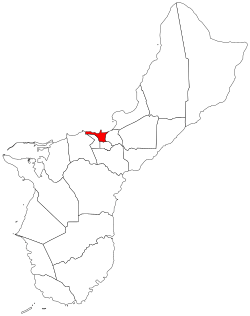 Location of Hagåtña (Agana) within the Territory of Guam | |
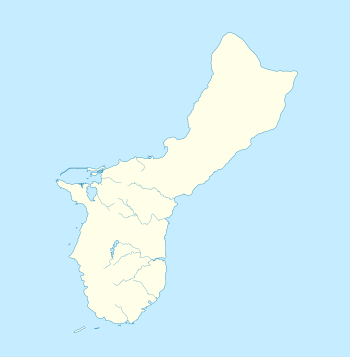 Hagåtña Location of Hagåtña (Agana) within the Territory of Guam .svg.png) Hagåtña Hagåtña (Earth) | |
| Coordinates: 13°28′45″N 144°45′00″E | |
| Country | United States |
| Territory | Guam |
| Government | |
| • Mayor | John A. Cruz (R) |
| Area | |
| • Total | 1 sq mi (3 km2) |
| Population (2010)[1] | |
| • Total | 1,051 |
| Time zone | UTC+10 (ChST) |
| ZIP codes | 96910, 96932 (PO Box) |
| Area code(s) | 671 |
Etymology
"Hagåt" (also romanized as haga', with a glottal stop instead of a syllable-final "t") means "blood" in the Chamorro language. The suffix "-ña" can be translated as either the possessive pronouns his, hers or its in English (cognate to -nya in Malay), or a signification of greater comparative degree, similar to some uses of the English suffix "-er". There is much speculation that the natives originally migrated from the village of Agat/Hagåt. Therefore, "Hagåtña" can be translated "his or her blood" possibly meaning "related to him, her or it", or it could be translated to what might roughly mean "more Hagåt", as in, an extension of the village of Hagåt. It could also mean "better Hagåt", or "more than, surpassing or superior to Hagåt" in a sense of being "more Hagåt than Hagåt itself". In 1998, the Guam Legislature changed the name from "Agana" back to the original Chamorro/Chamoru form. However, the name of the neighboring village Agana Heights remains unchanged.
Geography
Hagåtña is located at the mouth of the Hagåtña River on Guam's west coast. According to the United States Census Bureau, the city has a total area of 1 square mile (2.6 km²). The village is bounded by the sandy beaches of Agana Bay to the north, the Agana River and associated wetlands to the east, and a cliff (above which is the village of Agana Heights) to the South. Several high-rise office buildings are in the center of the village, while the western portion of the city known as Anigua is more residential. Unlike many villages, central Hagåtña is divided into city blocks with shops and small restaurants throughout the center of the village. Highly populated residential areas in the villages of Mongmong-Toto-Maite, Sinajana, and Agana Heights surround Hagåtña.
Climate
The city has a tropical rainforest climate (Köppen: Af), is similar to that found in the Amazon Basin.[4] Rainfall is high especially from June to November, reaching 978 millimetres (38.50 in) in a single month in August 1997, whilst the year 2004 was the wettest in history with 3,539 millimetres (139.33 in).[5]
| Climate data for Hagåtña | |||||||||||||
|---|---|---|---|---|---|---|---|---|---|---|---|---|---|
| Month | Jan | Feb | Mar | Apr | May | Jun | Jul | Aug | Sep | Oct | Nov | Dec | Year |
| Record high °C (°F) | 34.4 (93.9) |
33.9 (93.0) |
33.9 (93.0) |
35.6 (96.1) |
34.4 (93.9) |
35.0 (95.0) |
35.0 (95.0) |
34.4 (93.9) |
33.9 (93.0) |
35.0 (95.0) |
33.3 (91.9) |
32.8 (91.0) |
35.6 (96.1) |
| Average high °C (°F) | 29.4 (84.9) |
29.4 (84.9) |
29.9 (85.8) |
30.7 (87.3) |
31.1 (88.0) |
31.1 (88.0) |
30.6 (87.1) |
30.3 (86.5) |
30.4 (86.7) |
30.4 (86.7) |
30.3 (86.5) |
29.8 (85.6) |
30.3 (86.5) |
| Daily mean °C (°F) | 26.8 (80.2) |
26.6 (79.9) |
27.1 (80.8) |
27.7 (81.9) |
28.1 (82.6) |
28.1 (82.6) |
27.7 (81.9) |
27.4 (81.3) |
27.4 (81.3) |
27.6 (81.7) |
27.7 (81.9) |
27.3 (81.1) |
27.5 (81.4) |
| Average low °C (°F) | 24.2 (75.6) |
23.9 (75.0) |
24.2 (75.6) |
24.7 (76.5) |
25.1 (77.2) |
25.2 (77.4) |
24.8 (76.6) |
24.6 (76.3) |
24.6 (76.3) |
24.7 (76.5) |
25.1 (77.2) |
24.9 (76.8) |
24.7 (76.4) |
| Record low °C (°F) | 18.9 (66.0) |
18.3 (64.9) |
18.9 (66.0) |
20.0 (68.0) |
21.1 (70.0) |
21.1 (70.0) |
21.1 (70.0) |
21.1 (70.0) |
21.1 (70.0) |
19.4 (66.9) |
20.0 (68.0) |
20.0 (68.0) |
18.3 (64.9) |
| Average rainfall mm (inches) | 126 (5.0) |
115 (4.5) |
70 (2.8) |
91 (3.6) |
109 (4.3) |
180 (7.1) |
308 (12.1) |
436 (17.2) |
360 (14.2) |
300 (11.8) |
233 (9.2) |
152 (6.0) |
2,480 (97.8) |
| Average rainy days | 20.7 | 19.1 | 18.1 | 18.7 | 20.2 | 21.7 | 25.5 | 26.5 | 24.8 | 25.2 | 23.5 | 23.0 | 267 |
| Average relative humidity (%) | 77.6 | 76.3 | 74.8 | 75.7 | 76.9 | 77.4 | 80.6 | 83.2 | 84.2 | 82.8 | 81.1 | 79.2 | 79.2 |
| Source: pogodaiklimat.ru[5] and Weatherbase (humidity)[6] | |||||||||||||
History
| Historical population | |||
|---|---|---|---|
| Census | Pop. | %± | |
| 1960 | 1,642 | — | |
| 1970 | 2,119 | 29.0% | |
| 1980 | 896 | −57.7% | |
| 1990 | 1,139 | 27.1% | |
| 2000 | 1,100 | −3.4% | |
| 2010 | 1,051 | −4.5% | |
| Source:[1] | |||
.jpg)
.jpg)
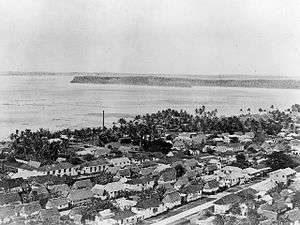
Hagåtña was a prominent village before Guam's colonization by the Spanish. In 1668, the first Spanish missionary, Padre San Vitores arrived on the island. The family of Chief Kepuha donated land in Hagåtña enabling San Vitores to build the first church (Dulce Nombre de Maria Cathedral-Basilica) on Guam.
Under Spanish rule, much of the indigenous population of Guam and other Mariana Islands was forced to relocate to the city. The remains of buildings from the Spanish administration can be seen in the Plaza de España located beside the cathedral of the Archdiocese of Agana. The remains of the Spanish Governor's Palace is here and is closer to the Department of Education than the Cathedral.
.jpg)
After Guam was ceded by Spain to the United States in the Spanish–American War of 1898, 'Agana' remained the seat of government under U.S. Naval Administration. By 1940, the city's population had grown to about 10,000 containing nearly half of the island's residents. Villages had been established nearby for immigrants from the Caroline Islands.
Guam was captured by Japanese forces on December 8, 1941. The Japanese, renamed Guam Ōmiya-jima (ja.: 大宮島) or Great Shrine Island, and Agana Akashi (ja.: 明石) or Red or Bright Stone. During Guam's 1944 liberation from the Japanese during World War II, the city was heavily damaged by U.S. naval bombardment. Many former residents settled in other parts of Guam after the war. As part of Guam's reconstruction plan, the U.S. Navy constructed new straight city streets that passed through existing lots and created many plots of land with multiple owners. This has hindered the development of the city to the present day. In December 1944 Guam was the scene of the Agana race riot, between black and white servicemen stationed on the island.
Today, despite a resident population of only 1,100 (less than 1% of Guam's total), the city remains the seat of the territorial government. Its historic sites are major attractions for visitors. Hagåtña is served by Antonio B. Won Pat International Airport in Tamuning and Barrigada.
Culture
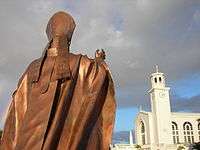
As Guam's historic population and administrative center, many traditional celebrations take place in Hagåtña. On December 8, Santa Marian Kamalen, Patroness of the Mariana Islands, is honored with a procession in which a statue of the patroness is pulled on a cart amid the prayers of thousands of the island's Catholics.[7] Guam's most celebrated patriotic holiday, Liberation Day, is on July 21. The annual Liberation Day Parade takes place on Marine Corps Drive in Hagåtña. In addition to the historic sites at the Plaza de España and the Basilica, Latte Stone Park and the Chamorro Village shopping area offer further information about the island's history and culture.
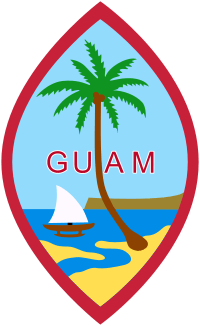
Diplomatic missions
The Taipei Economic and Cultural Office, of the Republic of China (Taiwan), is in Suite 505 of the Bank of Guam Building.[8]
Infrastructure and government
The island's capital, the legislature, the governor's office and other government offices are in Hagåtña. The Government House (Chamorro: Guma I Taotao Guam), traditionally the governor's official residence, is situated above the cliff but technically within the city limit of Hagåtña. Adelup, home of the Ricardo J. Bordallo Governor's Complex since 1990, was once part of Asan-Maina before being annexed into Hagåtña so that Hagåtña remains the seat of the Government of Guam. Adelup is used as a metonym in reference to Guam's government.
The Guam Department of Corrections operates the Hagåtña Detention Facility in Hagåtña.[9]
Notable federal government agencies in Hagåtña include the District Court of Guam at 520 West Soledad Avenue,[10] the United States Attorney at Sirena Plaza, 108 Hernan Cortez, Suite 500,[11] and the United States Postal Service Post Office at 223 West Chalan Santo Papa.[12]
International relations
Twin towns and sister cities
Hagåtña is twinned with:



Education
Primary and secondary schools
Public schools
The Guam Department of Education serves the entire island of Guam.
Hagåtña residents are zoned to:
- Carlos L. Taitano Elementary School (Sinajana)
- Jose L. G. Rios Middle School (Piti)
- John F. Kennedy High School (Tamuning)[16]
Private schools
Private schools in Hagåtña include:
- Academy of Our Lady of Guam (Catholic girls' high school in Hagåtña)
Public libraries
The Guam Public Library System operates the Nieves M. Flores Memorial Library at 254 Martyr Street in Hagåtña.[17]
Sites of interest
- Plaza de España
- Dulce Nombre de Maria Cathedral Basilica
- Agana Shopping Center
- Fort Santa Agueda
- Latte Stone Park
- Guam Museum
- Guam Congress Building
- Sirena Park
- Chamorro Village
- Paseo Stadium
- Chief Quipuha Park
- Agana Boat Basin
- Tollai Achote
- Ricardo J. Bordallo Governor's Complex
Notable residents
- Venancio Roberto, two-day Governor of Guam.[18]
- Jason Cunliffe, Guam international footballer.
- Kimberley Santos, Miss World 1980 (succeeded).
Mayors of Hagåtña
| Name | Term begin | Term end | Party |
|---|---|---|---|
| Commissioner of Hagåtña | |||
| Joaquin Cruz Perez | 1894 | 1899 | N/A |
| Antonio C. Suarez | 1918 | 1930 | |
| 1930 (as Chief Commissioner) | December 8, 1941 | ||
| Juan D. Perez | 1952 | 1962 | |
| Lucas L. San Nicolas | 1962 | January 1, 1973 | |
| Mayor of Hagåtña | |||
| Thomas F. Mendiola | January 1, 1973 | January 5, 1981 | Democratic |
| Felix F. Ungacta | January 5, 1981 | January 3, 2005 | Republican |
| John A. Cruz | January 3, 2005 | present | |
Gallery
- Map of Hagåtña
References
- "2010 Guam Statistical Yearbook" (PDF). Archived from the original (PDF) on 2014-07-23. Retrieved 2014-04-26. (4.3 MB), (rev. 2011)
- "Hagåtña". Dictionary.com Unabridged. Random House. Retrieved August 11, 2017.
- "» Hagåtña". www.guampedia.com. Archived from the original on 23 March 2018. Retrieved 31 March 2018.
- "Agana, Guam Köppen Climate Classification (Weatherbase)". Weatherbase. Retrieved 2019-06-20.
- "Климат Аганы - Погода и климат". www.pogodaiklimat.ru. Retrieved 2019-06-20.
- "Agana, Guam Travel Weather Averages (Weatherbase)". Weatherbase. Retrieved 2019-06-20.
- "Legend of Santa Marian Kamalen". ns.gov.gu. Archived from the original on December 8, 2006. Retrieved June 15, 2019.
- "Contact Us Archived 2011-07-18 at the Wayback Machine." Taipei Economic and Cultural Office Los Angeles. Retrieved on February 4, 2009.
- "Prison Security Archived 2010-09-24 at the Wayback Machine." Guam Department of Corrections. Retrieved on May 19, 2010.
- "District Court of Guam Archived 2009-02-28 at the Wayback Machine."
- "United States Attorneys Offices Contact Information Archived 2009-02-02 at the Wayback Machine."
- "Post Office Location - HAGATNA." United States Postal Service. Retrieved on December 4, 2008.
- "Sister Cities, Public Relations". Guadalajara municipal government. Archived from the original on March 2, 2012. Retrieved March 12, 2013.
- "Sister Cities". The Local Government of Quezon City. Archived from the original on 1 October 2017. Retrieved 9 April 2019.
- Raymundo, Shawn (June 17, 2017). "Guam, Philippines share long history of sister cities". Pacific Daily News. Retrieved January 12, 2018.
- "Department of Education - Public Schools". 22 February 2006. Archived from the original on 22 February 2006. Retrieved 31 March 2018.
- "Archived copy". Archived from the original on 2009-01-15. Retrieved 2008-09-09.CS1 maint: archived copy as title (link)
- Leon-Guerrero, Jillette (9 August 2010). "Guam Leaders from 1899-1904". Guampedia. Guam: University of Guam. Archived from the original on 26 July 2011. Retrieved 21 October 2010.
- Rogers, Robert F (1995). Destiny's Landfall: A History of Guam: University of Hawai'i Press. ISBN 0-8248-1678-1
- Carter, Lee D; Carter, Rosa Roberto; Wuerch, William L (1997). Guam History: Perspectives Volume One: MARC. ISBN 1-878453-28-9
- Sanchez, Pedro C. Guahan, Guam: The History of our Island: Sanchez Publishing House.
- (1996) Kinalamten Pulitikat: Sinenten I Chamorro: Issues in Guam's Political Development: The Chamorro Perspective: The Political Status Education Coordinating Commission. ISBN 1-883488-03-6
External links
| Wikivoyage has a travel guide for Hagåtña. |
| Wikimedia Commons has media related to Hagåtña. |
- Guampedia, Guam's Online Encyclopedia Hagåtña Village
- Hagåtña Guam at Guam Portal
- City of Hagåtña - Government of Guam
- Virtual Hagåtña
- . New International Encyclopedia. 1905.